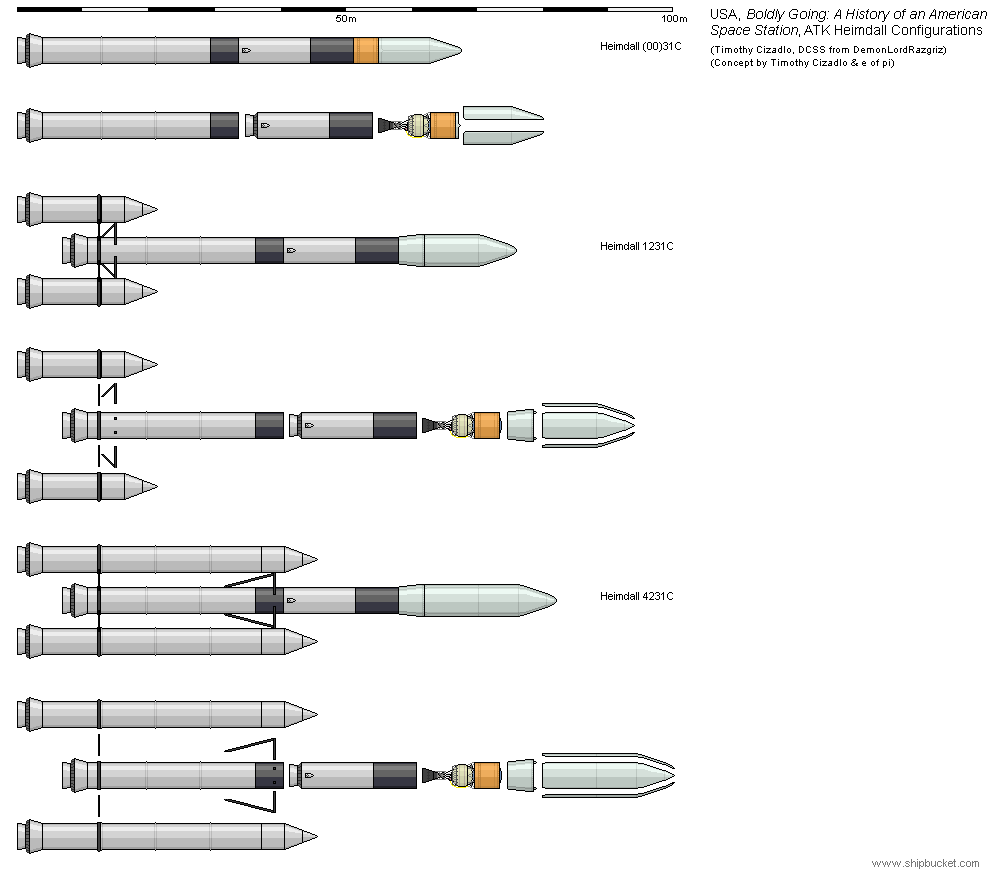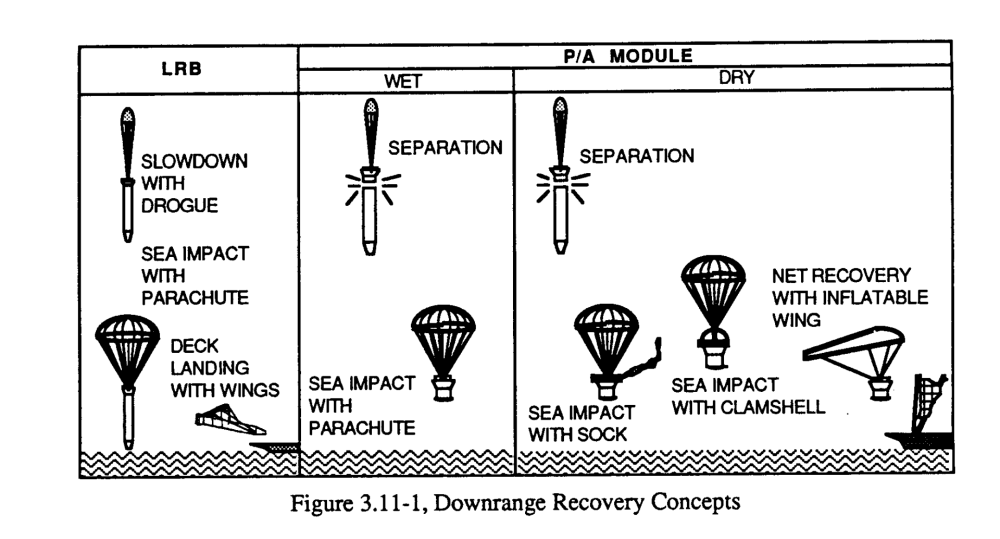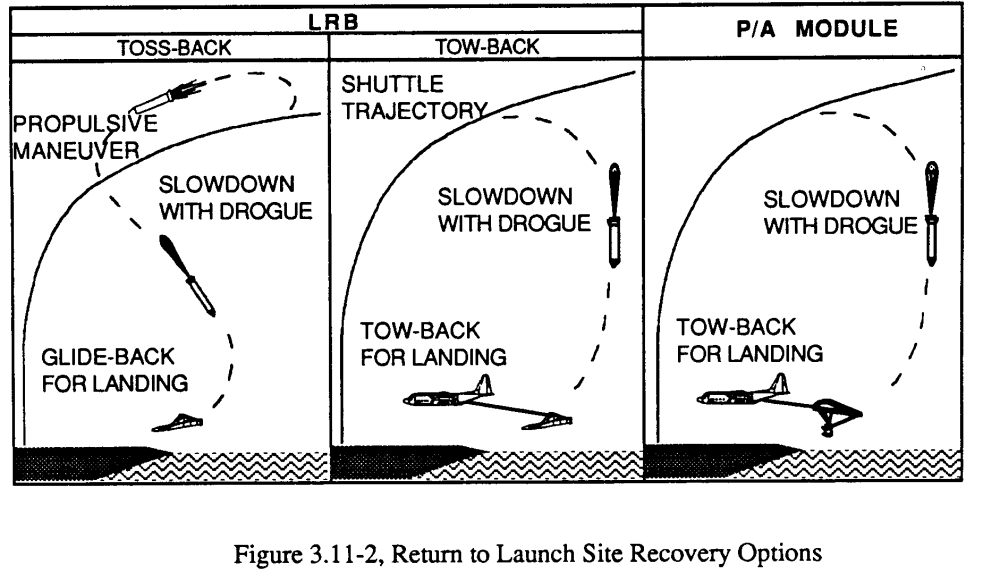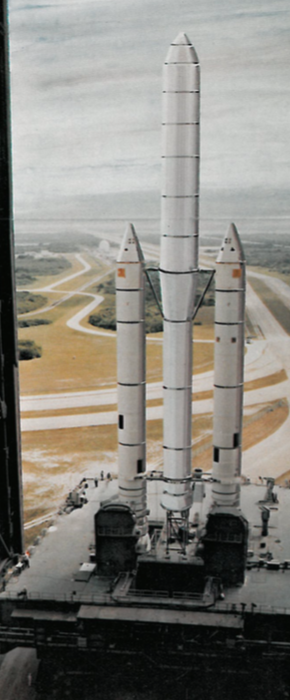Boldly Going Part 19
The Shuttle-C debut wasn’t the only place where Shuttle-heritage liquid and solid rocket boosters were being weighed against one another. Even before the tragic loss of
Discovery, forces within the Department of Defense had already questioned the wisdom of concentrating their entire heavy launch manifest on the Space Shuttle. With dubious flight rate assumptions and high operational costs, an alternative that would complement the shuttle was sought. Once the Space Shuttle returned to flight, these issues were only amplified, especially given the requirement to support every Shuttle mission out of Vandenberg with a second launch-on-need standby orbiter out of Florida. Thus, the DoD decided that it was in the interest of national security for them to maintain their own parallel stable of launch vehicles. The immediate result was the conversion of the Titan IV, originally intended to complement the Space Shuttle, into an entirely parallel program. The Titan IV, a derivative of the long-standing Titan vehicle, pushed its heritage to the limits in order to launch Space Shuttle-class payloads. However, it became clear that the Titan IV had very little remaining growth potential, and costs for the Titan-derived vehicles were spiralling upwards at dizzying rates. If the DoD was to have a parallel stable of launch vehicles as a backup or alternative to using NASA’s Space Shuttles, it would need a new vehicle, designed from the ground up to be cost-effective for the Department’s current needs. Beginning in the late 1980s, the DoD began incubating the concept of a new expendable launch vehicle program to replace the Titan IV and end dependence on Shuttle. In one of few solid policy actions taken in spaceflight between Bush’s 1989 Space Exploration Initiative speech and the 1991 formal authorization of
Space Station Enterprise expansion and the new lunar program, Congress authorized the DoD to conduct a competition to select a new “Evolved Expendable Launch Vehicle.”
In the original 1991 specification, the Department of Defense called for contractors to submit designs for a vehicle or family of vehicles capable of launching payloads ranging between 20,000 and 65,000 pounds to a low Earth orbit, with geostationary orbit performance of up to 25,000 pounds. Most companies submitted proposals, but when the downselections were made in late 1992, two proposals stood head and shoulders ahead of the pack both in terms of capability but also in terms of operational cost: Thiokol’s Heimdall launcher (the new marketing-approved name for a variant on their 1980s SRB-X family) and General Dynamics’ Atlas III (the marketing-approved name for that company’s proposal to use their Shuttle-C LRB engine pod mounted to a lightly modified tank set for a common-core booster). Drawing on the legacy of the existing Space Shuttle and the development already funded by NASA for the new Shuttle-C lunar launch vehicle, Heimdall and Atlas III offered relatively low development costs and strong payload growth potential. Moreover, though the DoD had not initially required consideration of recoverability and reuse in their bid specifications--a fact the “Expendable” in the competition name hinted at--the recoverability of significant portions of both vehicles helped boost their cost-competitiveness compared to the other alternatives.

Thiokol’s Heimdall was viewed as a low-risk and immediately available option. Better yet, the opportunity to support the heavy solid rocket booster production industry found powerful backers within the DoD and on Capitol Hill. Still, much as with the Space Shuttle and Shuttle-C, General Dynamics’ liquid booster offered increased performance and decreased maintenance time and cost. Though originally the EELV program had been expected to downselect to just one vehicle, it ultimately selected both of the two Shuttle-related vehicles in late 1992. The fact that both programs had powerful interests on the Hill helped protect the DoD from charges of unneeded duplication of contract costs, and having two vehicles with largely separate supply chains would help protect the DoD’s “independent” stable of launch vehicles from any stand-downs of NASA’s Space Shuttles. In such an event, the DoD could simply fall back to its other launch vehicle. In keeping with the reusability of both selected options, the program was renamed in 1993 into the National Security Space Launch (NSSL) program. By the end of the year, the Atlas III NSSL entry had been inherited by Martin Marietta when they completed a purchase of General Dynamics’ entire space division, including both the Shuttle-C LRB and its Atlas III derivative.

As had happened with Commercial Titan III, NASA too found benefits in the availability of a Shuttle-parallel cost-effective launch vehicle, both for flagship exploration missions and for the carrying out of tasks which would have otherwise required diverting scarce Space Shuttle launch windows to lower-priority but still schedule-critical missions. This was illustrated best with the debut of Thiokol’s Heimdall rocket in the spring of 1997, when NASA provided the DoD with payloads for the first several “risk-reduction” launches. These payloads were the satellites of the Lunar Data Relay System, revised versions of NASA’s existing TDRS satellite constellation able to handle the relatively minor differences between operations in geostationary orbit and operations in long-life halo orbits around the Earth-Moon Lagrange points EML-1 and EML-2. A set of three satellites at each of these points would extend NASA’s continuous communications and tracking relay system from low Earth orbit to anywhere in cis-lunar space or on the surface of the moon. While NASA weighed the benefits of waiting for Lockheed Martin’s liquid booster for Shuttle-C, the Thiokol Heimdall was proving its value paving the way for future astronauts with the launch of six LDRS satellites spread between three early Heimdall launches in 1997 and 1998.







